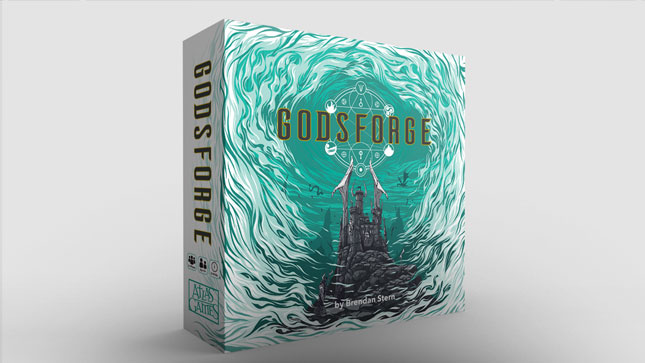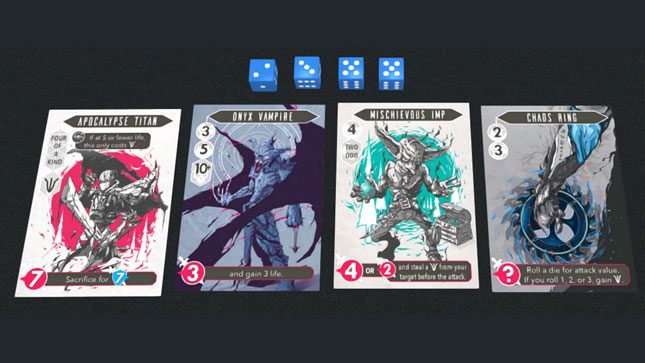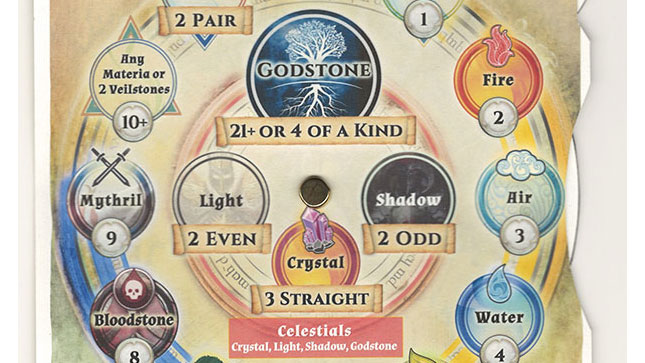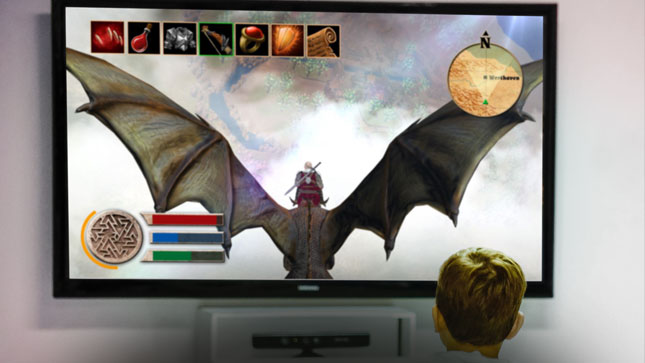Godsforge Strategy Guide
By Brendan Stern, 11-29-2022 | Updated on 12-10-2022
Godsforge is similar to games like Poker or Hearthstone Battlegrounds where there is a fair amount of luck involved, but you can make tactical key plays to increase your chances of winning. This guide is written for players familiar with the game looking to get an edge.
The Godsforge double expansions were a success with fans of the game pretty excited about it. The expansions come with many new unique card abilities, styles of play, and replayability. I’ll update this article in 2024 to reflect the new cards.
If you have questions about the rules or otherwise we often check the forums at Board Game Geek if you'd like to post there. Please give us a rating there if you enjoy this game.
A Balanced Strategy
In 3+ player games I find most wins come from a balanced strategy, one that has attacking and defending Creations, a little Veilstone generation, and a couple spells like big damage or a destroy effect. This type of strategy seems to outperform these strategies:
-
All attack Creations (you may kill a lot of players, but not survive)
-
All defense Creations (you might last until the end of the game, but ultimately lose because of not enough attack power)
-
Gaining lots of Veilstones and playing big spells (it is hard to fuel this win and it usually only wins if you are not attacked much)
-
Heavy Creation-destroying effects (this only can work if you have cards to help it win like Volcanic Sphinx)
A mixed strategy keeps you alive, puts pressure on the player to your left, and with a little veilstone generation, gives you options for destroying big cards anywhere on the board or playing a big damage spell.
In two-player games I favor big attack Creations and big damage spells. It is quite a different game than with 3 or more players!
A solo version of the game is now available where you can play solitaire against a set of cards. View the solo play PDF rules.
“The challenge is to whittle down the player to your left, while simultaneously building your defenses against the one on your right. Play too defensively and the player on your left gets too powerful! Play too offensively and you get decimated by the player on your right! The game is fast so you can play a few times a night.” -BGG review by Paddlefish.
A Good Opening Hand
It is helpful to get one to three cards in your opening hand that require three or less dice to play and ideally have different card costs in case the dice roll one way or the other. This will give you a good chance of playing a card on round one, and also possibly gain one or two Veilstones, making future cards easier to play. One or more of these cards should be Creations or Spells that put Creations into play so you can build your board up and have greater power over time.
One of the best new rules in the coming expansion is how you create your opening hand. You can use this rule immediately for the base game as well:
New Optional Mechanic: Draw 10, Keep 4
For the first Upkeep, you may, instead of performing any card discards and draws, have all players draw ten cards, keep four, and then shuffle their remaining six back into the deck. If you are playing with the Great Houses cards from the expansion, you may choose which side of your house card to use after looking at your 10 cards.
Know When to Play Your Cards
Each card is good either in the early game, mid game, or late game. The best advice I can give is to aggressively discard cards you are holding that are not good for the time of the game you are in.
Play Veilstone Generators Early
Cards like Veilstone Beacon or Emerald Treant that generate Veilstones over time are typically best played in rounds one and two. If you play them on rounds 3-5 it will typically be too late to take advantage of them. Playing them after round 5 is almost always going to be bad for you unless you have a spell like Drain Life that can take advantage of them and keep you alive, you have a lot of Creations with empower abilities, or you have a Creation in play like Leviathan that is fueled by Veilstones.
Also, playing more than one of these types of cards often leads to losing the game. It is more important to establish Creations with attack and defense in addition to Veilstone generation.
Play Big Damage Spells Later in the Game
While Spells like Fireball can be fun to unleash for their large splashy effects, they are often best played later in the game to finish off a player. In the early rounds of the game you typically want to play Creations, because they stay in play for the remainder of the game, gaining you attack, damage prevention, or help you gain Veilstones.
That said, sometimes it can be advantageous to remove a player early to gain 3 Veilstones, especially if you think their defenses are building up too much and you need to take them out early. This can be doubly true if you have a card like Chain Lightning when you want to take out a player two places to your left. However, be careful of eliminating players that are not on your left because another player will collect three Veilstones!
Another note, in our playtests the card Earthquake performed well when played early to mid game because it takes away a Forge Roll die from the player to your right. That has proven to be a very strong ability, and that comes up more often in the expansions.
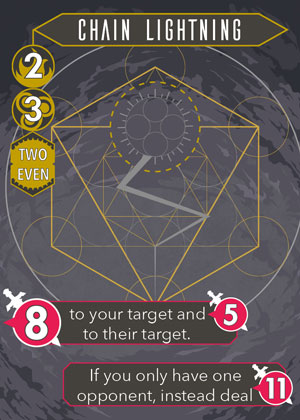

Best Early Game Cards (Ranked in order, first is best)
Onyx Vampire (possibly best round one play), Mischievous Imp (one of my favorite cards in the game), Scepter of Fortune, Veilstone Beacon, Volcanic Sphinx, Crystal Phoenix, Chaos Ring.
Best Mid Game Cards
Spellbind (one of the best cards in the game), Apocalypse Titan (good any time), Etherium Cannon, Doppelganger, Malachite Manticore, Airship, Dimension Door (if you can play it) Shadow Gorgon (sometimes great late game), Veilstone Thief (if timed correctly), Topaz Basilisk (better in 3+ player games with a good target in play), Leviathan (in certain situations), Winds of Fate (when the player to the right has a lot of Veilstones and might throw a big spell at you, see if they start fiddling with or counting their Veilstones).
Best End Game Cards
Heart of the Forest, Crystal Barrier, Fireball, Drain Life, Elemental Storm, Wall of Stone, Earthquake.
We kept a log of what cards were a part of a winning game vs. a losing game. There is one card in the game that I have heard no one say is overpowered, but it had the highest "when played, you won" ratio. However, it wasn't played that much, maybe because it looks underwhelming and people don't understand it's power level. I won't reveal the card for now, but possibly later if people want me to.
It is not a bad idea to discard cards if you have them in your hand at the wrong time of the game. There are exceptions to this rule of course.
Specific Cards to Watch For
Crystal Barrier and Heart of the Forest
These two cards are very strong, and the key is to play them as late in the game as possible, maybe even after one player has been eliminated, letting other players take damage while you defend it all.
When attacking someone who might play these cards, try playing Fireball (below), which cuts through a Crystal Barrier. Elemental Storm may do way too much damage for the Barrier to prevent. A new card in the expansion, Counterspell, will completely negate Crystal Barrier.
Heart of the Forest is harder to deal with, but the best spell counter is Banish (below), which destroys the Heart before the Attack phase. Another good counter is mounting early damage to take it out quicker. In the expansion, there are MANY cards that deal with Heart of the Forest. Many Creation destroying and stealing effects occur during the Reveal in the expansions, weakening the Heart, yet it is still one of the best cards in the game.
If you anticipate your opponent playing one of these two cards, keep an eye on their Forge Roll to see which they may be playing.
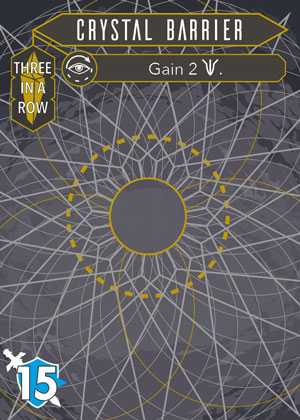
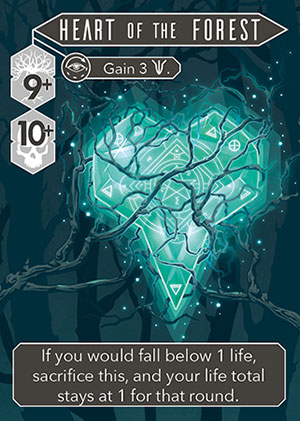

Overrated Card: Crystal Phoenix
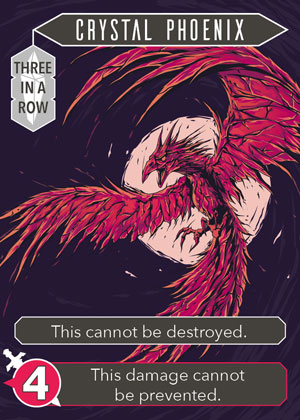
The Phoenix is certainly a good card, but many have said it is overpowered or even should be removed from the game! I think it is a solid round one or even round two play, but then it is almost unplayable in rounds three and beyond, except once in a while where you need to sneak four damage past defense at the end of the game. What this card is good at doing in a 3+ player game is killing the player to your left, but not necessarily winning the game. In a two player game there are often stronger options.
The best counter to this card is life gain or a card that steals your opponent’s cards. These are harder to find in the base game, but with both expansions you will find many more opportunities to deal with the Phoenix.
Underrated Card: Leviathan

Oh boy, almost everyone hates this card. It is tough psychologically because it can feel like a trap, like you’ll sacrifice all your Veilstones or Creations and die. My playtesters thought this card was super weak, but then I told them, “Leviathan dealt 32 damage this game. It was the reason I just won.”
This card is a trap if you play it too early or late. However, this card can be one of the strongest mid game plays, rounds 4-5, if you have a few extra Veilstones or Creations to sacrifice. Remember, you can sacrifice Leviathan to itself. If you think of it like a Spell that costs “3-dice” to get 8 damage, and then “3 Veilstone” for 8 more damage each round, this is pretty efficient damage for its cost. Plus, this card can steamroll players, because when you kill a player you gain three Veilstones, allowing Leviathan to keep kicking butt.
Plan Out Your Rerolls
After you make your initial Forge Roll you get two rerolls to use. Sometimes your dice are perfect to begin with, but other times you need to carefully plan your rerolls and work through your odds of success. Take for example this opening hand and this initial Forge Roll of 2, 3, 5, 5.

With this roll you can already play the Chaos Ring because you have a 2 and a 3. It is not a bad round-one play so you could go with that, but you should reroll a five to see if you get a one or a six in order to gain a Veilstone when you Reveal your card.
If you rerolled a five and got a one or a four, you could also play the Mischievous Imp, using 4, 3, 5 to pay for the card and you could reroll the last 2 to see if you could get a one or a six.
An often forgotten rule is you can add your dice together, so if your initial 3 when rerolled becomes a 2 you could use both 2’s for your 4 cost and your two 5’s for two odd cost.
Onyx Vampire is one of the best round-one plays in the game, and maybe you want to go for it here. The risk isn’t too bad, but there is a chance you might not play a card. You would reroll the 2 and hope for a 1, 5, or 6 to pay for the 10+ cost. You get two rerolls to get it, so your odds are decent for success. If you happen to reroll and get a 2, you could still play the Chaos Ring. If you roll a four, you could play the Imp. But if you roll a three, you are stuck with nothing to play on round one. If it were me, I might roll one time to see what I get. If I have a card I can play after the first reroll, I might stay with that and not reroll a second time to avoid that three. But you could always risk it, and try to get a better roll.
If your initial roll was 2, 3, 1, 6 you could consider playing the Chaos Ring from the 2 and 3, but then also collect two extra Veilstones from your 1 and 6. This could set you up to play the Apocalypse Titan on round two, which you were unable to play on round one because it requires four dice and a Veilstone.
Also, it doesn’t hurt to keep an eye on your opponents’ rolls too because sometimes people make “creative errors” when paying for their cards.
Rock, Paper, Scissors
Godsforge has a rock, paper, scissors dynamic with attack, damage prevention, and gaining Veilstones. You can stop an aggressive attacking player to your right with strong damage prevention, but if that same aggressive attacker instead went with defense or Veilstone generation, your heavy defense would do nothing, and you will likely need to vary your tactics and start adding attack or you could lose the game.
This is why a mixed approach is important. If your first three rounds have one attacker, one defender, and one Veilstone generator, then you can adjust your strategy based on what other players are doing.
If the player to your right is playing defensively or generating Veilstones you may want to consider gaining more Veilstones yourself instead of mounting more attack power. This helps you play more powerful cards. You may also want to consider destroying or stealing cards from the defensive player to your right, putting them on their back foot.
Choosing the Right Creations to Destroy
One of the most challenging and high level choices in Godsforge is knowing what Creations to destroy. Typically you'll find yourself wanting to destroy a Creation with a large attack value controlled by the player to your right. However, this isn't always the correct choice. Game states can get pretty complicated and sometimes you'll need to take out a Creation controlled by the player who you think may have the strongest board. This can be a risky play, but it is often needed to win the whole game rather than surviving until you're eliminated shortly thereafter by the dominant player.
Expansion Strategy: Twilight of the Great Houses
In the Twilight of the Great Houses expansion, each player gets one of sixteen new unique starting abilities. It is critical to take advantage of your ability and look for a few cards that will enhance it. I’ll be writing up key cards for each House and strategies to pair with them in Q1 of 2023.
Do you have any strategies that make you a better player in Godsforge? What cards do you think are under or overpowered? Leave a comment below.
